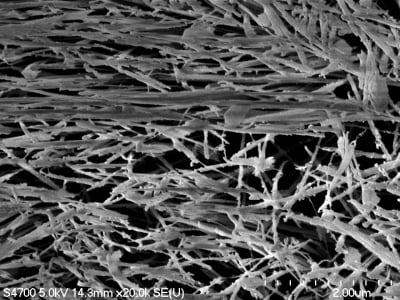2021-09-22 アメリカ合衆国・ミシガン工科大学

・ ミシガン工科大学が、カーボンナノチューブ(CNTs)を利用した、ナノコンポジット(ナノ複合材料)による 3D プリント用高分子インクを開発。
・ 引張強度や軽量性に優れる CNTs をはじめ、グラフェン、金属ナノ粒子や量子ドット等の低次元ナノ材料をインクに加えることで、3D プリント作製した材料に電気や熱の伝導性、磁力や電気化学的貯蔵等の機能性を付与する。
・ 3D プリンティングでのプラスチックや金属等の材料の使用は新しいものではないが、本研究の独自性は、エポキシ樹脂、CNTs およびナノクレイから成る高分子ナノ複合材料と、それらの機能性を損なわせないプリンティングプロセスを利用した点。
・ 同ナノインクの導電性は、3D プリントしたエポキシ樹脂製品に回路基板、航空機の翼や血管にカテーテルを誘導するアクチュエーター等の電気配線の機能を付与する。また、鋼鉄やアルミニウムと同等の強度を提供しながら重量を 80%低減し、従来のエポキシ樹脂を代替する優れた特性が期待できる。
・ CNTs による機械的強度の向上により、マイクロスケールの欠陥から始まる微細な亀裂をつなぎ合わせてその拡大を防止する。欠陥や損傷が致命傷となる医療、航空宇宙、電子産業の分野では、同ナノインクは安全機能を提供する。
・ 高分子ナノ複合材および 3D プリント製品・サービスはそれぞれ 10 億ドル産業である一方で、ナノ材料による 3D プリンティングの市場価値は僅か約 4 千 3 百万ドルにとどまる。
・ これは、プロセス、ナノ材料の形態・構造と特性の関係性が十分に理解されていないことで、3D プリンティングプロセスでのナノ複合材の特性の制御方法が欠如しているため。本研究では、3D プリンティングにおけるマクロスケールの力学と、ナノ複合材料におけるナノスケールの力学と物理的現象の間の複雑な相互作用の理解を試みた。
URL: https://www.mtu.edu/news/2021/09/3d-nanoinks-push-industry-boundaries.html
<NEDO海外技術情報より>
(関連情報)
Additive Manufacturing 掲載論文(アブストラクトのみ:全文は有料)
Additive manufacturing of conductive and high-strength epoxy-nanoclay-carbon nanotube
composites
URL: https://www.sciencedirect.com/science/article/abs/pii/S2214860421002633?via%3Dihub
Abstract
Additive Manufacturing has increased our ability to fabricate complex shapes and multi-material structures. Epoxy is excellent as the base for structural composite materials. Furthermore, carbon nanotube (CNT) is an outstanding filler due to its unique properties and functionalities. Here, conductive epoxy-nanoclay-CNT nanocomposite structures were fabricated by direct-write 3D printing. In this process, 3D-printable composite inks were synthesized by incorporation of nanoclay and different concentrations of CNTs – 0.25, 0.5, and 1 vol%, 0.43, 0.86, and 1.7 wt% – in epoxy. CNTs were found to significantly improve the electrical and mechanical properties. Rheological characterization of the inks revealed a shear-thinning behavior for all the nanocomposite inks and an increase in the complex viscosity, storage, and loss moduli with the incorporation of CNTs. The CNT concentration of 0.5 vol% was found to be the optimum condition for enhancement of mechanical properties; an average increase of 61%, 59%, and 31% was measured for flexural strength, flexural modulus, and tensile strength, respectively, compared to the 3D printed epoxy-nanoclay nanocomposite structures. The electrical conductivity of 2.4 × 10−8 and 2.2 × 10−6 S/cm was measured for the nanocomposites containing 0.5 and 1 vol% CNTs, respectively. Multi-scale characterization of the morphology revealed partial alignment of CNTs in the direction of printing, CNT pull-out and breakage at the fracture surfaces, and nano-scale interactions of the constituents, all of which contribute to the superiority of the nanocomposite with CNTs. The findings show the promise of this ink material and printing method for various applications such as aerospace structures and electronics.


